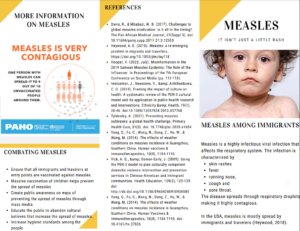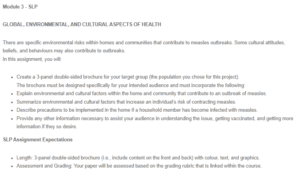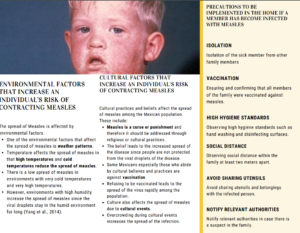Global, Environmental, and Cultural Aspects of Health – Measles

ORDER A PLAGIARISM-FREE PAPER HERE
We’ll write everything from scratch
Question
Global, Environmental, and Cultural Aspects of Health – Measles
Module 3 – SLP
GLOBAL, ENVIRONMENTAL, AND CULTURAL ASPECTS OF HEALTH
There are specific environmental risks within homes and communities that contribute to measles outbreaks. Some cultural attitudes, beliefs, and behaviours may also contribute to outbreaks.

Global, Environmental, and Cultural Aspects of Health – Measles
In this assignment, you will:
- Create a 3-panel double-sided brochure for your target group (the population you chose for this project).
The brochure must be designed specifically for your intended audience and must incorporate the following: - Explain environmental and cultural factors within the home and community that contribute to an outbreak of measles.
- Summarize environmental and cultural factors that increase an individual’s risk of contracting measles.
- Describe precautions to be implemented in the home if a household member has become infected with measles.
- Provide any other information necessary to assist your audience in understanding the issue, getting vaccinated, and getting more information if they so desire.
SLP Assignment Expectations
- Length: 3-panel double-sided brochure (i.e., include content on the front and back) with colour, text, and graphics.
- Assessment and Grading: Your paper will be assessed based on the grading rubric that is linked within the course.
Module 3 – Background
GLOBAL, ENVIRONMENTAL, AND CULTURAL ASPECTS OF HEALTH
- Read at least two of the following articles to learn more about the PEN-3 model as a framework for planning programs that consider cultural and environmental influences on health behaviours.
- Iwelunmor, J., Idris, O., Adelakun, A., & Airhihenbuwa, C. O. (2010). Child malaria treatment decisions by mothers of children less than five years of age attending an outpatient clinic in south-west Nigeria: An application of the PEN-3 cultural model. Malaria Journal,9(1), 354-354. doi: http://dx.doi.org/10.1186/1475-2875-9-354
- Iwelunmor, J., Newsome, V., & Airhihenbuwa, C. O. (2014). Framing the impact of culture on health: A systematic review of the PEN-3 cultural model and its application in public health research and interventions. Ethnicity & Health, 19(1), 20-46. doi:10.1080/13557858.2013.857768
- Naghibi, S. A., Shojaizadeh, D., Montazeri, A., & Yazdani Cherati, J. (2015). Sociocultural factors associated with breast self-examination among Iranian women. Acta Medica Iranica, 53(1), 62-8.
- Shahandeh, K., Basseri, H. R., & Sharifzadeh, Y. (2014). An application of the cultural model to assess and compare malaria prevention among Afghani migrants and Baluchi residents in the endemic area, southeastern Iran. Journal of Immigrant and Minority Health, 16(1), 102-110. doi:10.1007/s10903-013-9850-4
- Yick, A. G., & Oomen-Early, J. (2009). Using the PEN-3 model to plan culturally competent domestic violence intervention and prevention services in Chinese-American and immigrant communities. Health Education, 109(2), 125-139. doi: http://dx.doi.org/10.1108/09654280910936585
Additional Resources
- Paiz, J. M., Angeli, E., Wagner, J., Lawrick, E., Moore, K., Anderson, M., . . . Keck, R. (2016, May 13). General format. Retrieved from https://owl.english.purdue.edu/owl/resource/560/1/
- Paiz, J. M., Angeli, E., Wagner, J., Lawrick, E., Moore, K., Anderson, M., . . . Keck, R. (2014, November 11). In-text citations: The basics. Retrieved from https://owl.english.purdue.edu/owl/resource/560/02/
- Paiz, J. M., Angeli, E., Wagner, J., Lawrick, E., Moore, K., Anderson, M., . . . Keck, R. (2014, November 11). Reference list: Basic rules. Retrieved from https://owl.english.purdue.edu/owl/resource/560/05/


